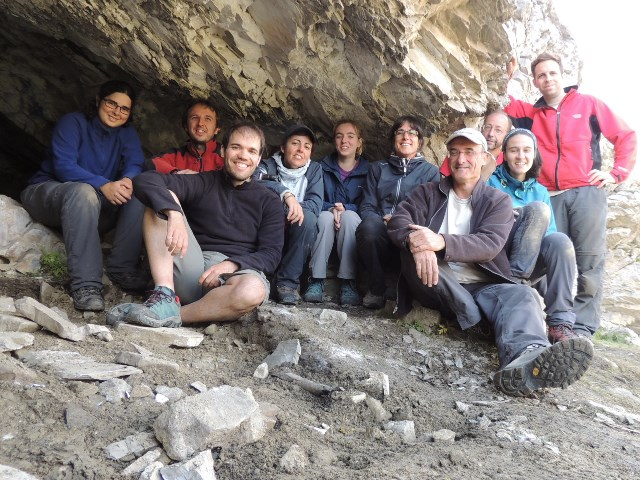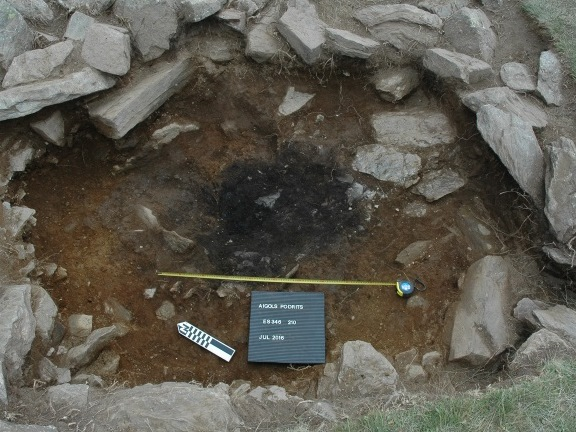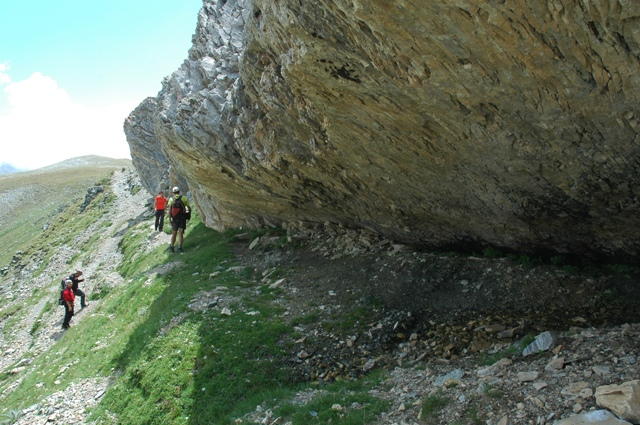
A team led by IPHES is carrying out an archaeological intervention in cave 338 (or “Catau de l’Os”), located at 2,250 m, in a strategic enclave of the Pyrenees, a halfway between the Núria valley and the top of Puigmal, the highest peak in the area.
From August 26 to September 6, a team from the Catalan Institute of Human Paleoecology and Social Evolution (IPHES) and the Prehistory Area of the Rovira i Virgili University (URV), under the direction of Carles Tornero and Eudald Carbonell, is leading an extensive excavation in prehistoric cave 338, in the Catalan Park Natural Capçaleres del Ter y del Freser (Queralbs), within the framework of a research project in collaboration with the Catalan Institute of Classical Archeology (ICAC).
More than 10 years of GIAP archaeological research in the Pyrenees
Previous archaeological works by GIAP team, led by Josep Maria Palet (current director of the Institute), together with Hèctor A. Orengo and Arnau Garcia- Molsosa, documented for the first time in 2012 the occupation of cave 338 in the Middle Neolithic in the 4th millennium BC, an extraordinary finding that represented the oldest documented human occupation in the Núria Valley to date.
The archaeological campaign was part of the InterAmbAr research project (2010-2012), funded by the Spanish Ministry of Science, and coordinated with the Paleoenvironment R&D subproject of the CSIC (led by Ramon Julià, Jaume Almera Institute of Earth Sciences – CSIC, and Santi Riera, from SERP-UB).
GIAP team identified the cave in the Núria valley in 2012, and it was documented in the Middle Neolithic, reoccupied in the late medieval phase.
The results on human occupation in the Núria and Coma de Vaca valleys led to new landscape archeology projects in these high-altitude spots, with the inclusion of palaeoenvironmental studies and new interventions in which many other points of interest were investigated, showing the deep anthropization of these spaces for about 7,000 years.
In this context, and within the framework of the SUMA project, ICAC and IPHES organized a joint intervention in 2017, co-directed by Josep Maria Palet, Lídia Colominas and Tania Polonio from the GIAP team. In this intervention, different diagnostic studies were carried out in the deposits, and the existence of important prehistoric occupations at the entrance of the cave could be corroborated.

Check out more information about the results of this joint intervention here: “Hem posat les bases per patrimonialitzar l’arqueologia de Núria” (ICAC, January 12, 2018).
In search of the first human populations in the Pyrenees
The remains recovered in the cave (among others, combustion basins for the exploitation of malachite, charred vegetable fuel, fragments of the consumed animals, or pieces of hand-made ceramic vases) indicate the use of the cavity from the Middle Neolithic to the Middle Ages; that is, for about 5,500 years.

Historically, the area where cave 338 is located has been closely linked to the livestock use of the extensive surrounding meadows during the summer season, as a natural refuge for the shepherds who accompanied the flocks, generally sheep.
One of the purposes of the current archaeological intervention is to know the use that the cavity had by the first human populations that used it.
One of the working hypotheses of the current intervention is to test whether the first prehistoric occupations documented in the cave were already associated with this livestock activity in high mountain areas and to corroborate whether this cavity could have other functions and uses.
Other prehistoric archaeological sites documented at a similar height and in other areas of the Pyrenees are located in small shelters or structures with stone foundations in the open air, usually with archaeological records poorly preserved due to the acidity of the soils and the greater exposure of their deposits out in the open. The good conservation observed in cave 338 makes the recovery of a unique and exceptional record at this height probable.

In addition to the archaeological excavation, the project includes a plan for the protection of the cavity for safeguarding, as well as the dissemination of the scientific results, resources that will be useful for the Natural Park Capçaleres del Ter i del Freser.
The ICAC has already developed different transfer and dissemination activities to value the archaeological heritage of this area of the Pyrenees, based on the results of the more than ten archaeological campaigns carried out in this area by the GIAP research team. A good example is the archaeo-tracks, designed by Josep Maria Palet and Pau Olmos, available as tracks with archaeological interest in the Natural Park Capçaleres del Ter i del Freser since 2018.

2021 archaeological excavation is carried out within the framework of the quadrennial project ‘Arrels prehistòriques de la transhumància a l’Alt Ripollès: projecte arqueològic 2018-2021’ (CLT009/18/00048), with the funding of the Department of Culture of the Generalitat de Catalunya, and the Queralbs City Council; under the direction of archaeologists Carles Tornero (postdoctoral researcher María de Maeztu at IPHES) and Eudald Carbonell (professor of Prehistory at the URV and researcher at the same center).
Project ‘Arrels’ is co-directed by Carles Tornero and Eudald Carbonell, from IPHES, and has the participation of the ICAC, with GIAP researchers Josep Maria Palet, Lídia Colominas, Pau Olmos y Tania Polonio.
Amb el suport de






